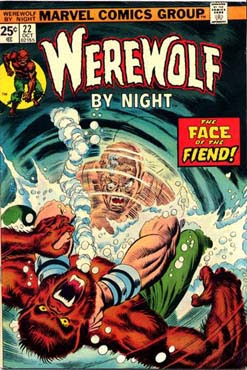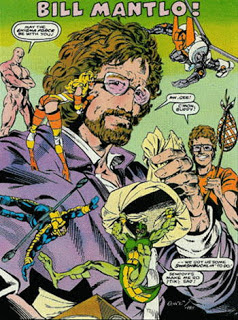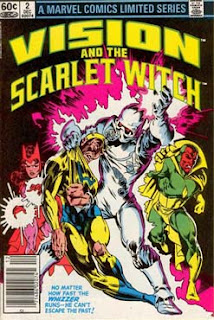Martinex1: Earlier this month was the birthday of one of the Bronze Age's most creative, productive, and prolific writers - Bill Mantlo. Born November 9th 1951, Mantlo joined with Marvel Comics in the mid-1970s and by the end of that decade was involved with some of their most popular books.
His first Marvel work was as a colorist for
Werewolf By Night #22 in October of 1974. He colored a number of books in his early months with the company, including
Avengers #129.
Bill Mantlo would ultimately be known for his writing and that started with
The Deadly Hands of Kung Fu # 7 (December 1974), in which he wrote "Tigers in a Mind Cage." He continued writing for the black and white mag
Deadly Hands of Kung Fu for many issues while continuing his coloring duties for the comic book lines. Along with George Perez, Mantlo created the White Tiger in December of 1975 for the magazine.
Mantlo's first writing work for the mainstream comic line, was in
Adventure into Fear with The Man Called Morbius The Living Vampire #29 (Phew... that is quite a title). The story Mantlo wrote was "Through a Helleyes Darkly." It was cover dated August of 1975.
In the early going, Mantlo was assigned stories with a horror theme like the Morbius tale. He wrote The Frankenstein Monster #18, and when he got his first shot with a Marvel hero - it was the Thing teamed up with the Golem in Marvel Two-In-One #11.
Mantlo was already showing his proficiency, having only been with Marvel for about a year. He quickly took on a lot of work. By the latter half of 1975, he was writing multiple books per month and was involved with Iron Man, Marvel Chillers, Power Man, Marvel Two-In-One, Marvel Premiere (with Hercules), and Astonishing Tales (starring Deathlok). He also wrote issues of Thor and The Defenders.
At only 23 or 24 years old, Mantlo had made a name for himself as a quick study and also capable of quick turnaround for single issues and fill-in issues. In an era when the "Dreaded Deadline Doom" seemed to encroach on the monthly distribution for numerous titles, Bill Mantlo was cranking out story after story. He even plotted Uncanny X-Men #96 to be scripted by Chris Claremont.
Some of my favorite Mantlo penned stories include his work in
Marvel Premiere with the story of Woodgod, as well as his work on the
Champions, and for the "real life" heroics of
The Human Fly.
Mantlo was not afraid to take on new challenges while also being extremely creative within the sandbox that Marvel supplied. He frequently created brand new characters and was not intimidated by licensed properties (which would ultimately bring him his greatest recognition and success).
His imagination and creativity knew no bounds during his prolific tenure. As I noted in a previous panel discussion, Bill Mantlo created the Jack of Hearts. Also along the way he created characters like the Soviet Super-Soldiers, the U-Foes, and even Rocket Raccoon. If you did not know, Rocket made his debut during Mantlo's run on the Hulk. His hand was also in the development of Cloak and Dagger.
In 1979, Mantlo took two licensed properties and developed comic runs that are among my favorites of the Bronze Age.
The Micronauts and
ROM Spaceknight arrived, confronted with my typical skepticism that would accompany any toy generated characters of the time. My Marvel super-hero elitism was showing, but when I was exposed to the complex "toy" stories which included ties to Marvel mainstream characters, I liked the books immensely From Inner Space to the southeastern U.S., the Micronauts were revolutionaries fighting against the tyrannical Baron Karza and avoiding the deadly Body Banks while searching for some sort of galactic meaning. Meanwhile, ROM of Galador fought the shape shifting scientific sorcerers, the Dire Wraiths. Both had campy B-movie serial elements, but both also had some significant depth of characterization and layered plots. Mantlo wrote the entire series of both
ROM and
Micronauts uninterrupted; he was truly the auteur of those runs.
As mentioned, Mantlo worked on The Hulk for a while. He also took over the writing chores on Alpha Flight when John Byrne left the book. In my opinion, those are lesser efforts as I felt that Mantlo was a more in depth writer who employed layered character development more frequently when the characters were of his making.
Here are some samples of of pages using his scripts and dialogues. I think that he bridged the hammy explanatory wordiness of the Silver Age with the eloquence and complexity of the Bronze Age nicely.


Shown below are just a handful of the hundreds of comic book stories that Bill Mantlo penned. From Tarzan to Howard the Duck, from Ghost Rider to Red Sonja, from Man From Atlantis to the Yancy Street Gang, Mantlo was there.
Among my favorites are the Iron Man issues depicted; they are from the conclusion of the Midas arc. I feel it set a mood for the book that was carried on during the Michelinie-Layton days. One criticism that I have heard about Mantlo is that he had so many ideas that it disrupted his execution; the ideas were flowing so fast that they did not have time to mature to be explored in full. I tend to disagree; I think he used language and the pace of the story to keep the reader enraptured. And I think he did it well. He didn't linger too long on the minutia. It may not have been "high art" but it was entertaining comic reading. Some of his stories are definitely better than others; sometimes it is very apparent he was under a deadline and cranking out the issue. But in other cases, I find the comics very compelling.



In the 1980s, Bill Mantlo attended law school and began work as a public defender. Unfortunately, he was the victim of a hit-and-run while he was rollerblading. He remains in assisted care to this day. Bill Mantlo definitely brought me hours and hours of enjoyable fantastic tales through Marvel Comics. I miss his input on the medium tremendously; and I wonder what he would have given us if he had continued writing. If you are curious about his comic impact, check out
Mantlo, A Life in Comics. It was authored by his brother Michael and David Yurkovich (I believe some of the proceeds go toward Bill's care).
So what do you think about Bill Mantlo's influence on the Bronze Age of comics? Are any of his books in a stack of your favorites? How did his writing stack up against the greats - in your opinion? What would you have liked to have seen more of (or less of) from Mantlo? Share your thoughts on the man, his writing art, the comics he created, and his influence today at BitBA! Cheers!


































































